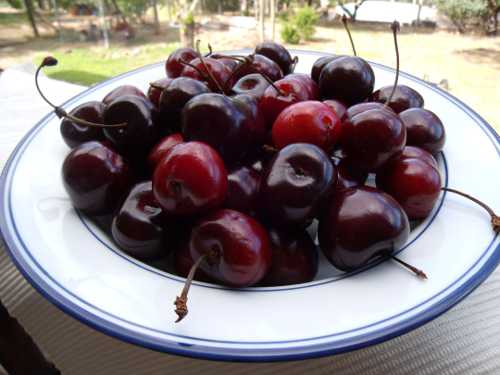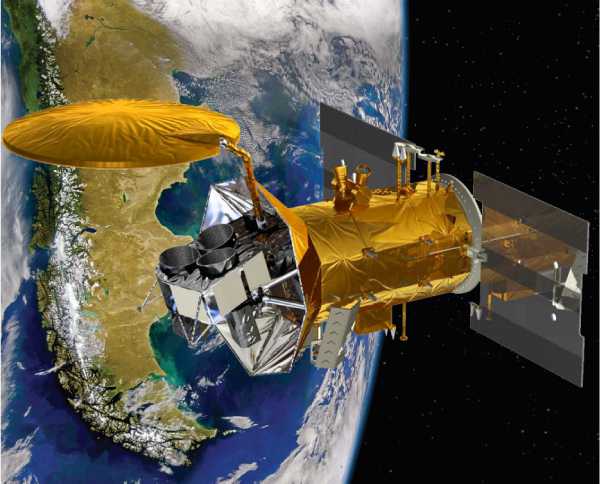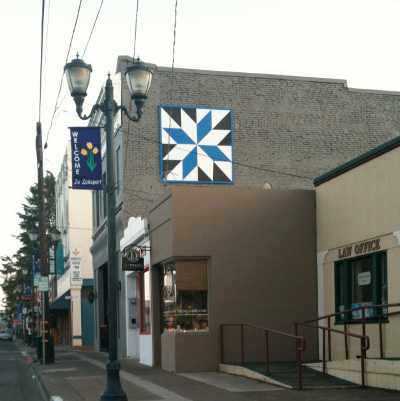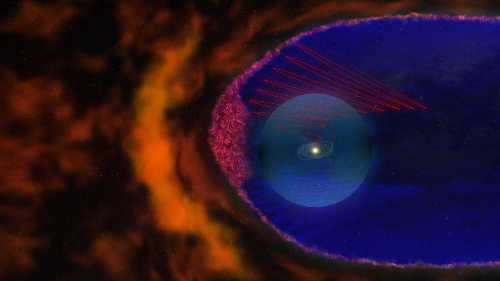- Lake County News Reports
- Posted On
The Veggie Girl: Cherry cheer

If “life is just a bowl of cherries” as the song implies, then we’re truly blessed.
The welcome sight of these bright, shiny fruits snuggled together in a bowl is almost guaranteed to lift one’s spirits.
Colorful, sweet and tasty, cherries are nearly universally loved. And they’re healthy to boot, all of which bode well for a positive life.
The cherry blossoms of spring lead to fruit in the early summer (the peak of season is late June), and local farmers’ markets have them available now, fresh from the tree.
There are two species of cherry, sweet and sour.
Sweet cherries are the ones we find most often in markets (whether farmers’ or otherwise). High in sugar content – from 10 to 20 percent – sweet cherries are perfect for eating out of hand.
The popularity of sweet cherries is reflected in the astounding amount of cultivated varieties, about 900 in all. Among the best known sweet cherries are the deep burgundy Bing and the yellow, rosy-cheeked Ranier.
Sour cherries, also known as pie cherries, are tart due to high acidity, but when mixed with sugar, this quality makes for a wonderful cobbler or pie. There are about 300 varieties of sour cherries.
Both sweet and sour cherries are descendants of the wild cherry, which had a native range that extended through most of Europe, Western Asia and parts of North Africa. They were consumed in these areas since prehistoric times, and cultivation dates back to 300 B.C.
Cherries are known as “super fruits” because of their high levels of cancer-fighting antioxidants. Tart cherries, in particular, have among the highest levels when compared to other fruits.
In addition, cherries have beta carotene (more than strawberries or blueberries), vitamin C, potassium, magnesium, iron, fiber and folate.
Cherries also contain melatonin, a substance which has been found to regulate the body’s sleep patterns in addition to preventing memory loss and delaying the aging process.
Emerging evidence links cherries to a variety of health benefits, from helping to ease the pain of arthritis and gout to reducing risk factors for diabetes, heart disease and certain cancers.
Bright, sweet cherries make a nice pairing on a platter for ripe cheeses such as brie or strongly-flavored goat cheese, and in recipes with mild ricotta cheese.
Cherries are wonderful with both the mild sweetness of white chocolate and the bittersweet taste of dark, either dipped whole or in recipes. Another sweet that works well with cherries is caramel.
Alcohols such as brandy, Gran Marnier and cognac complement cherries, as does kirsch (which in German means “cherry water”), a brandy made with cherries, most often served as an aperitif.
Nuts go well with cherries, too, such as almonds, hazelnuts, pistachios and walnuts. A favorite scone of mine is one with cherries (either fresh or dried), chocolate (either dark or white) and almonds. A heavenly combination!
A refreshing “black fruit salad” – perfect for summer – may be made by combining pitted fresh dark cherries, black grapes, blueberries and black currants with a bit of brown sugar and fresh lemon juice. Let the mixture sit for about two hours, tossing a few times.
Combine the fruit juices that settle on the bottom with sour cream for a topping and garnish with mint.
Cherries soaked in brandy (fantastic over vanilla ice cream or custard) make a nice gift and are easily made.
To do this, fill a container with firm whole cherries, either sweet or sour, add sugar (about one cup to every two pounds of cherries) and fill container to within an inch of the top with brandy. Allow cherries to macerate at room temperature a month or two, and then move to the fridge.
If tart cherries are used, use more sugar, about one and a half cups per two pounds of cherries.
A large portion of the U.S. cherry crop is grown in Michigan, and when a friend of mine returned from visiting her home state, I was presented with a gift of the largest, sweetest, most succulent dried cherries I’ve ever seen.
Other than tossing them in salads, including them in granola and using them in baking, dried cherries, especially the tart ones, may be combined with other fruits, ginger, spices, vinegar and sugar to make an especially pleasing chutney.
I made a cherry-red wine reduction with some of my dried cherry treasures, which I used over puff pastry that I stuffed with Gorgonzola cheese, spinach, walnuts and dried cherries. It can also accompany roasted chicken.
My recipe for the sauce is below, but first, a bit of history.
Below the words to “Life Is Just a Bowl of Cherries” are written. It was recorded in 1931 at the height of the Depression, making it especially poignant. Songwriters Lew Brown and Ray Henderson used cherries as a metaphor for enjoyment of the fleeting happy moments of life.
Life Is Just a Bowl of Cherries
Life is just a bowl of cherries.
Don't take it serious; it's too mysterious.
You work, you save, you worry so,
But you can't take your dough when you go, go, go.
So keep repeating it's the berries,
The strongest oak must fall,
The sweet things in life, to you were just loaned
So how can you lose what you've never owned?
Life is just a bowl of cherries,
So live and laugh at it all.
And along the way, don’t forget to stop and smell the cherries. (They’re a member of the rose family, after all.)
Red wine-cherry reduction
1 cup red wine, any variety (other than dessert wine)
½ cup unsweetened 100 percent cherry juice *
½ cup reserved water from rehydrating dried cherries *
¼ cup dried cherries (not rehydrated)
2 tablespoons unsalted butter
*Or 1 cup cherry juice.
Use wine to deglaze skillet in which chicken was seared.
Add cherry juice (and water, if using) to pan, along with dried cherries.
Simmer steadily, stirring occasionally, until liquid is reduced by about half and coats a spoon.
Add butter and swirl pan or stir until melted.
Note: For vegetarian version, combine liquid in small saucepan rather than skillet and proceed as above.
Recipe by Esther Oertel.
Esther Oertel, the “Veggie Girl,” is a culinary coach and educator and is passionate about local produce. Oertel teaches culinary classes at Chic Le Chef in Hidden Valley Lake, Calif., and The Kitchen Gallery in Lakeport, Calif., and gives private cooking lessons. She welcomes your questions and comments; e-mail her at This email address is being protected from spambots. You need JavaScript enabled to view it..
Follow Lake County News on Twitter at http://twitter.com/LakeCoNews , on Facebook at http://www.facebook.com/pages/Lake-County-News/143156775604?ref=mf , on Tumblr at http://lakeconews.tumblr.com/ and on YouTube at http://www.youtube.com/user/LakeCoNews .

 How to resolve AdBlock issue?
How to resolve AdBlock issue? 









